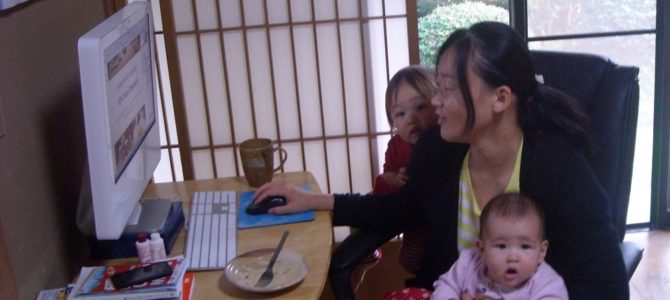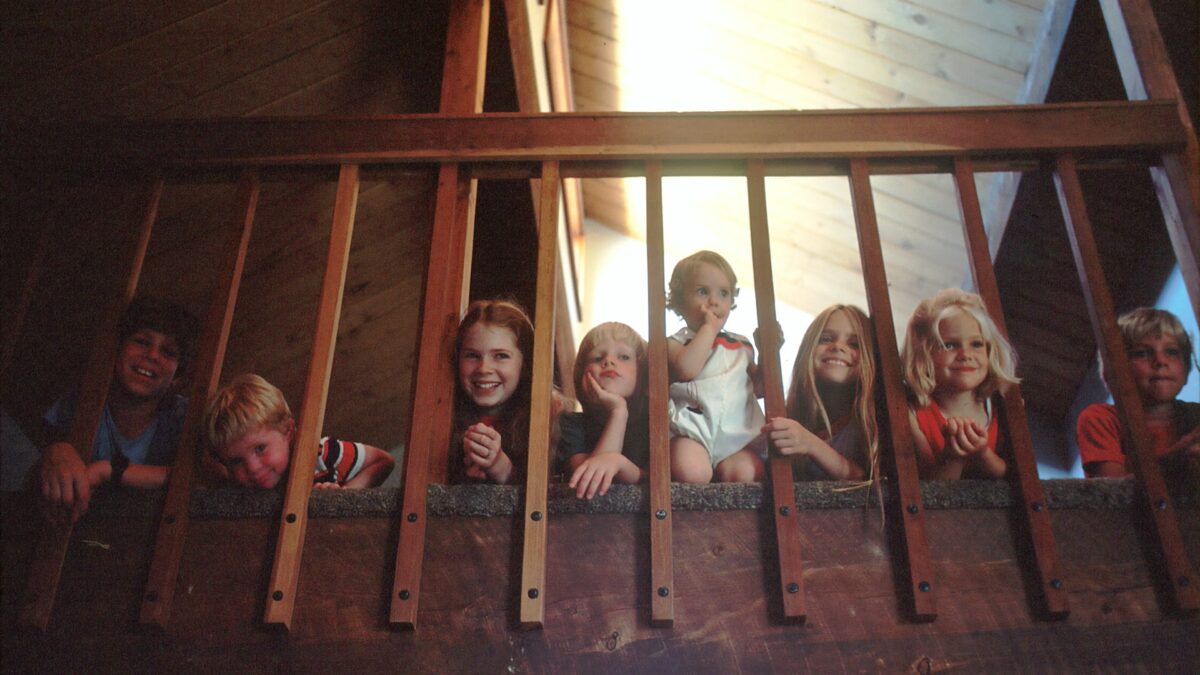
So far, approximately 26 million of the nation’s 58 million K-12 school children are affected by school closures stemming from worries over the Wuhan virus, according to Education Week. Working parents, who are the vast majority of U.S. parents, are thus left to cover both childcare and work for somewhere between two and four weeks. Since coronavirus most significantly affects the elderly, having grandparents or an aunt or uncle fill in is probably not the safest choice.
So what is a working parent to do? I’ve worked from home surrounded by children for the past decade. Yes, we have arranged our family life to have daddy or a babysitter with our kids during most of my routine work hours, or for me to work while the kids sleep, because focused work is much better than distracted work.
But I’ve had my share of babysitter cancellations, quarantines due to family sickness, my husband unexpectedly needing to put in extra hours, going on the radio while the toddlers are awake, and work butting into what is supposed to be family time because of breaking news or a sick colleague. This is just life with kids. We’re also a low-screen family because we don’t like what screens do to our brains and relationships. My kids average 1-2 hours on screens per week.
So here are my top tips for managing work and kids without just handing them the Kindle or iPad for the next month.
1. Give the Kids Attention First
I have learned this basic principle the hard way: Fill your kids’ attention cups before you switch your attention to work. If you meet your kids’ needs first, they will be less likely to nag and pester you while you are working.
Make sure they’ve had the meal, snack, and diaper change they need. Get them going with an activity. Spend 30-45 minutes reading them a book, playing a game, getting into a craft, or working a puzzle. Meet their relationship and physical needs before you try to get some work done. Trust me, this will make for a better day.
2. Do Your Most Focused Work When the Kids Sleep
Anyone who has had a baby has heard the adage for newborns, “Sleep when the baby sleeps.” Well, if you’re working at home while caring for kids, work while the kids sleep. Work before they get up in the morning, work during naptime, and work after they go to bed at night. Yes, it’s disruptive, but yes, it helps you pack in needed work hours while spending less time distracted in the presence of your children.
If your children are older and do not nap, institute a two-hour afternoon quiet time. Give them a few options for quiet activities and tell them they may not pester you until quiet time ends. Then enforce the quiet rule sternly. My husband tells the children, “Don’t call me unless you are bleeding or someone is stealing you away.”
3. Switch Between Kids and Work in Solid Chunks of Time
You will do both your best work and your best childcare if you can group each item into a larger chunk of time, as opposed to trying to work and watch kids at the same time. This helps you focus on whatever it is you’re doing, which helps whatever that is to be handled much better.
An exception to this are emails that require little real attention (i.e., that do not require very careful writing and thinking). That you can stick into the corners of your time if you want, although doing so will still produce some distracted brain effects from task-switching, so I try to reduce this if possible but will do it on a very busy day.
So, for example, a sample work plus kids block schedule might look like this:
6-7 a.m.: Work while the kids sleep.
7-9 a.m.: Kids wake up, feed them breakfast, read them books, then give them a craft or activity to do (or, for older children, assign them some homework or make them go outside to play or walk around the block).
9-10: While the kids are occupied, dive into work and try to “clear the decks.” Do triage: Most urgent things first, then things that can be dispatched quickly. This will probably take your whole hour.
10-10:30: Move your kids onto the next part of their homework checklist if they are school-aged, or bring out a new activity for them if they are preschoolers and toddlers.
10:30-11:30: Knock out another block of work, this time switching to something that requires more time and focus than a “clear the decks.”
11:30-1:30: Spend this chunk of time with your kids. Put lunch together, throw a load of wash in the washer together, walk the dog, read a book aloud together after or during lunch, and then set up the afternoon quiet activity.
1:30-3:30: Quiet time for kids while mom and/or dad works. Do your hardest and biggest jobs right here.
3:30-5:30: Regroup with the kids, put them to work on household chores (even toddlers can pick up their toys), plan and make dinner, eat.
5:30-8: Family time. Perhaps one spouse can work while the other occupies the kids.
8-9:30: Kids in bed, knock out some more work if you need to. Usually after a long day like this, this is the best time for catch-up work, smaller tasks that don’t require much time, energy, or brainpower, such as email.
Yes, it’s a strenuous schedule, but notice that you were able to put in a seven- to eight-hour work day during it just by chunking the activities. You can keep this up for two weeks to a month.
4. Rotate Childcare With Your Spouse or a Working Friend
A way to get out of the all-day schedule outlined above would be to switch work hours with your spouse or a working parent friend whose kids are also out of school due to the closures. My husband teaches, so he has summers off. During that time, then, he works mornings 7-2 and I work afternoons and evenings, 2-6 and 7-10 (break for dinner).
If you are a single working mom, or a parent in a two-income household, you could pair up with friends or family in the same boat and switch off child care for each other similarly. (By the way, this is one of my favorite ideas for how single moms can work while keeping their kids out of daycare in non-coronavirus situations, too.)
5. Develop Your Kids’ Repertoire of Games
When I first became a mom it was surprising to discover that children don’t necessarily know how to play, so they need to be taught. Before there were so few children, so many screens, and so much adult micromanagement, older kids naturally passsed down play possibilities. But now, because our communities and relationships are so decimated, it takes active and conscious work to achieve what former generations provided naturally.
One of the best ways to develop your children’s self-management and relationship skills while they have a lot of fun is through games. Last summer, I developed a day camp to help my kids, their friends, and others in the community develop a classic games repertoire they could use for the rest of their lives, to keep these skills alive. You can get the how-to handbook of the 32 classic games we learned here. Learn them together, play them together, then set your kids free to use during these weeks of unstructured time.
6. Assign a Younger Kid to an Older Kid
Some siblings don’t pair well together at certain stages of their lives. But many siblings, especially those with a bigger age gap, can be very affectionate and play together very nicely. Put this blessing to good use during this time of family need by assigning your big kid(s) to play with or read to your younger kid(s) during a chunk of time you can then devote to work.
This also works between a pair of siblings who are closer in age. Assign one to be the “sitter” or the manager of the next hour of their activities together, then switch the responsibility to the other. It will keep them busy and you free to get some work done.
7. Rotate Activities and Keep Some In Reserve
We have five kids and five billion toys. Even people with fewer kids have billions of toys. It’s the American way.
One way I handle all this clutter is to rotate the kids’ toys and keep a closet of activities I’ve picked up on sale to bring out in times of need. I keep approximately half our toys in the attic — except the Legos, which are always out — and when the kids seem to be listless and bored about the current set I retire several things and replace them with the attic stores. When they haven’t seen a toy in two months, they are much more interested in playing with it.
When I have an emergency like having to be on the radio when my babysitter just bailed on me a half hour ago, then I reach into what my husband calls my “closet of wonder” and pull out a sticker book, some new play clay, paint by number books, and so forth, set them up 10 minutes before the radio call, then go hide in the closet to do radio. Another tactic that works very well is to give then a special snack from a cabinet of wonder where I hide the best ones for such moments of need.
If you have toddlers, my favorite activity to keep them confined and occupied for a surprisingly long time is sticking them in the bathtub. Sit there with your laptop to make sure they don’t drown, give them some bath toys and bubbles, and ride that puppy as long as it will last.
8. Set the Timer
It really helps my kids to know how long mom is going to be not paying attention to them while working, or how long they need to practice their piano before I let them go, or when quiet time will end. So for these situations I set a timer they can watch count down that gives a satisfying beep at the end.
9. Send the Kids Outside in All Weather
This is one of those tactics that works best if you have trained your children into it over time, but it will still have some use if you haven’t yet. We send our kids outside just about every single day, rain or shine, cold or hot. On very hot or cold days we’ll give some weather mitigation like snowpants or a sprinkler, but enforced outside time is good for the kids and good for parents’ nerves.
All you have to do is tell them it’s time to go outside, and if they balk set a time limit on it and explain how you will help them deal with the rain or snow by making sure they are warm and dry with the right outerwear. Tell them they are welcome to jump in puddles and get their pants all wet. Then absolutely refuse to let them inside until at least 20 minutes have passed (unless, of course, it’s dangerously freezing or something). Lock the door and don’t respond to them if necessary. I promise, nothing bad will happen.
10. Audiobooks Are Screens With Nearly None of the Negatives
We don’t consider audiobooks screen time even though many of ours play on a Kindle, because there is nothing to beep and boop or look at. You just sit there, or play with Legos or Play-Doh, and listen. An audiobook is an excellent option for afternoon quiet time.
Children who are used to sensory overload from video games and TV may need to develop their attention spans to be occupied by an audiobook. Having them do a quiet activity such as painting or Legos while they listen is a great way to wean them from that and help restore their attention spans.
You can get a huge range of free audiobooks from Librivox, and audiobooks that are very well-produced with voice actors and often sound effects from Audible, Jim Weiss, or Focus on the Family Radio Theatre (which has enthralling production quality — it sounds like a movie without the visuals). Your local library, like ours, may offer well-produced free online audiobooks as well.
11. Start an Activity With Them, Then Leave
It helped me to realize that I don’t have to stay there doing an activity with my kids the whole time, but that I just need to do what teachers call “scaffolding” — erecting a support system for as long as needed, and then dismantling it when it’s no longer needed.
So pull out the blocks or the train set and if your kids are reluctant or claim it’s boring, just start building something cool with it by yourself. Nine times out of ten, your kid will get interested and join in. After you are both having a good time, and your child is self-directing his play, then you can leave if you need to. Or stay and enjoy your child.
12. Make Your Home Conducive to Self-Directed Play
We have deliberately bought and created play and hobby spaces for our kids and made them accessible. For example, I put all the craft supplies in one drawer organizer kit that sits on a special art table, so the kids can color, paint, glue, cut, and staple whenever they want. We bought a trampoline on Craigslist that is used almost every day of the year. Best $100 I ever spent. My husband made a puzzle table by adding a lip around a secondhand coffee table and cutting Plexiglass for a top to keep the baby from wrecking the latest creation.
I call things like these “stations.” You can set up your own craft and hobby stations just by putting the supplies for some activity in a container where the kids can reach them. We also cull kid craft books from library and garage sales for a quarter or two, because they give the kids inspiration.
You can create your own “stations” too, just by grouping supplies and inspiration books in places kids can reach, giving them a quick lesson or getting one from a site like Skillshare, CreativeBug, or free painting classes on YouTube from my fellow Hillsdale alum and amazing artist Emily Olson.
13. Get Used to Not Very Much ‘Me Time’
When you work from home and have children, you have a lifestyle that affords very little downtime for yourself. That’s just a tradeoff you make for holding down two full-time jobs. Realizing and accepting that this is the way it is will help reduce your frustration with having 95 percent of your waking hours spoken for by other people.
Gratitude for what you do have — a way to support your family plus kids you love deeply — will also help keep you from inwardly or outwardly whining about the circumstances. Attitude affects your children and entire home atmosphere, so it’s up to you to look on the bright side and choose to rejoice in your many blessings instead of complaing about things you can’t change.
14. Get Your Kids Used to Managing Themselves
If you develop a lifestyle that incorporates things like the above, as well as developing your children’s hobbies and skills that require their own independent work, interest, and focus instead of shuffling them from one adult-managed activity to another, your children will become used to managing themselves.
This is what brain researchers and psychologists call “executive function,” and it is very important to helping children grow into competent adults. The lack of self-directed play and graduated skill development has contributed to iGen and millennials’ immaturity and dependence on their parents.
So you have a great opportunity in this next two weeks to month of self-directed time to start on a path to family growth that will help your children become more competent adults. Start here, but don’t just stop after life returns to normal. Keep up routines and strategies like these to help your children grow in self-reliance long-term.









